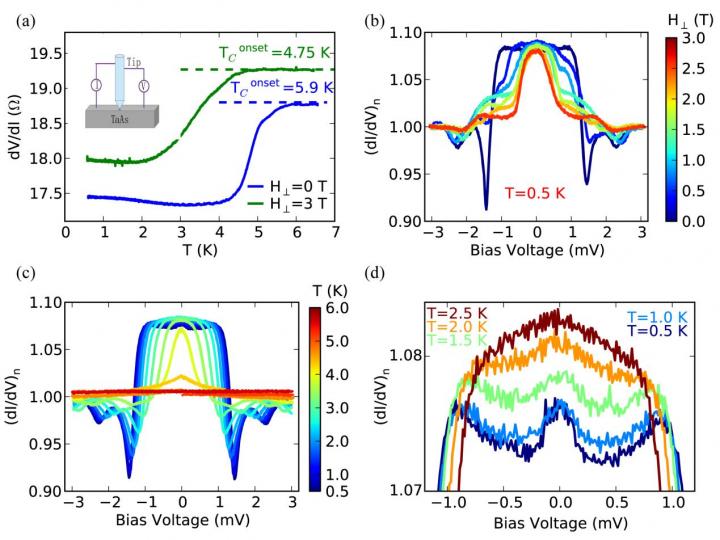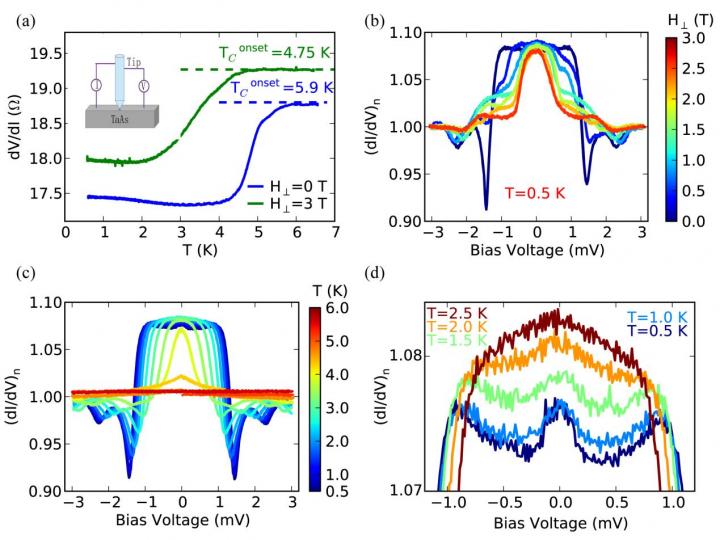
Credit: ©Science China Press
Recently, Prof. Jian Wang in collaboration with Prof. Jian Wei, Prof. Xiong-Jun Liu, Prof. Shuang Jia at Peking University and Prof. Yong Wang at Zhejiang University, discovered tip induced unconventional superconductivity by hard point contact on Weyl semimetal TaAs crystals, which might be topological non-trivial. Topological superconductors have attracted great attention for their ability to host Majorana zero modes, which could be used in topological quantum computation. Therefore, the present discovery not only opens a new route in investigating the novel superconducting states based on Weyl materials, but also demonstrates a new method to induce potential topological superconductivity by hard point contact modulation on non-superconducting topological materials.
This work has been published in Science Bulletin 2017(6) issue with the title of "Discovery of tip induced unconventional superconductivity on Weyl semimetal". Prof. Jian Wang, Prof. Jian Wei and Prof. Xiong-Jun Liu are corresponding authors of this paper. He Wang, Huichao Wang and Yuqin Chen contributed equally to this work. Jiawei Luo helped in point contact measurements. The TaAs samples were grown by Zhujun Yuan and Prof. Shuang Jia. The tunneling electron microscopy (TEM) study of TaAs showing atomic structures was carried out by Jun Liu and Prof. Yong Wang.
Topological superconductors show superconducting gap in bulk state but support gapless Majorana fermions or Majorana zero modes in the boundary, of which the Majoran zero modes obey non-abelian statistics and can be applied to topological quantum computation and to build a fault-tolerant quantum computer. Scientists have been mainly searching for topological superconductors by superconducting proximity effect in hybrid structure of superconductor-topological material or superconductor-spin orbit coupled material. In 2016, Prof. Jian Wang in collaboration with Prof. Jian Wei, Prof. Xiong-Jun Liu, Prof. X. C. Xie and Prof. Shuang Jia at Peking University, reported unconventional superconductivity induced by hard point contact on 3D Dirac semimetal Cd3As2 crystals (Nature Materials 15, 38 (2016)). The results reveal a new way to detect and study potential topological superconductivity by using hard tip/point contact on topological non-trivial materials, which is different from the prevailing proximity effect method for realizing topological superconductivity and Majorana fermions.
Weyl fermion, the long pursued massless Dirac fermion with definite chirality, has been realized as low-energy excitation around Weyl point in Weyl semimetal, which possesses Weyl fermion cones in the bulk and nontrivial Fermi arc states on the surface. Being of topological Fermi surfaces, Weyl semimetals could be natural candidates for the realization of topological superconductors if superconductivity can be induced. Recently, Prof. Jian Wang and collaborators reported the discovery of PtIr tip induced unconventional superconductivity on non-superconducting Weyl semimetal TaAs single crystals. The point contact spectroscopy exhibits zero bias conductance peak and double conductance peaks as well as double conductance dips, which reveal the characteristics of unconventional superconductivity. Furthermore, the control experiments show that the W tip can also induce superconductivity but the relatively soft Au tip cannot induce superconductivity on TaAs crystals. It means the local "uniaxial" pressure and doping effect etc around point contact region are important to the appearance of superconductivity. Theoretical study further suggests that the induced superconductivity on TaAs may have nontrivial topology. Thus, this work demonstrates an effective method to detect and study topological superconductivity by using hard tip point contact on non-superconducting topological Weyl semimetals.
Prof. Jian Wang, Prof. Jian Wei, Prof. Ji Feng and Prof. Xiong-Jun Liu etc also previously studied Au2Pb superconductor by hard point contact measurements (npj Quantum Materials 1, 16005 (2016)). When "soft" Au tip is used, the superconducting transition temperature obtained by point contact spectroscopy is same with the result obtained by standard four-electrode measurement. However, when "hard" W tip is used, the superconducting transition temperature obtained by point contact spectroscopy is significantly enhanced. These results further demonstrate that the point contact measurement technique is reliable to induce and detect superconductivity and could become a universal method to realize novel superconductivity on topological non-trivial materials.
Point contact measurement was previously considered in a few cases to study superconducting materials. The present work reports the developed technique to induce superconductivity on non-superconducting topological materials by using non-superconducting tip (hard point contact), different from previous point contact experiments, where the samples are superconductors themselves. Therefore, the present discovery may motivate more investigations to fully reveal the topological superconductivity induced by hard tip on topological materials.
###
This work was financially supported by National Basic Research Program of China (2013CB934600, 2012CB927400, 2012CB921300, and 2016YFA0301604), the Research Fund for the Doctoral Program of Higher Education (RFDP) of China, the Open Project Program of the Pulsed High Magnetic Field Facility (PHMFF2015002), Huazhong University of Science and Technology, Open Research Fund Program of the State Key Laboratory of LowDimensional Quantum Physics, and the National Natural Science Foundation of China (11474008 and 11574008).
See the article:
He Wang, Huichao Wang, Yuqin Chen, Jiawei Luo, Zhujun Yuan, Jun Liu, Yong Wang, Shuang Jia, Xiong-Jun Liu, Jian Wei, Jian Wang. Discovery of tip induced unconventional superconductivity on Weyl semimetal, Science Bulletin 2017, 62(6)425-430
doi: 10.1016/j.scib.2017.02.009
Science China Press
http://www.scichina.com/
Media Contact
Jian Wang
[email protected]
http://zh.scichina.com/english/
############
Story Source: Materials provided by Scienmag





